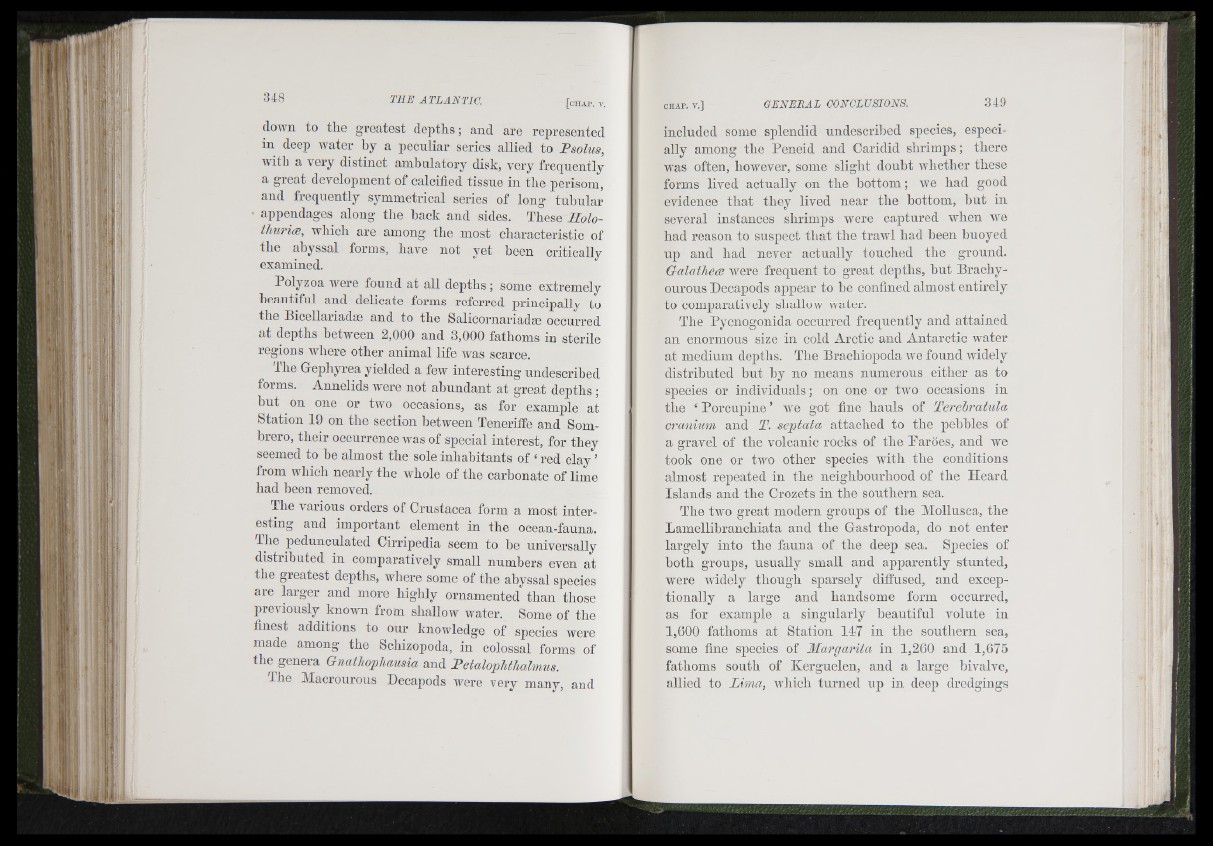
K-;: . - ,1 r
I i '
11
to*!:
A I to,
,g: 5
totoiih , ;4|i 'II
il'
ii.'
A m
■ 'il
I i i ' '" k i\
I? I i i '
» liSito'
■ i : . F
down to tlie greatest deptlis; and are represented
in deep water by a peculiar series allied to Fsolus,
witb a very distinct ambulatory disk, very frequently
a great development of calcified tissue in tlie perisom,
and frequently symmetrical series of long tubular
appendages along tbe back and sides. Tbese llolo-
tlmri(B, wbicb are among tbe most cliaracteristic of
tbe abyssal forms, bave not yet been critically
examined.
Polyzoa were found at all depths; some extremely
beautiful and delicate forms referred principally to
tbe Bicellariadm and to tbe Salicornariadm occurred
at depths between 2,000 and 3,000 fathoms in sterile
regions ivbere other animal life ivas scarce.
The Gephyrea yielded a few interesting nndescribed
forms. Annelids were not abundant at great depths;
but ^ on one or two occasions, as for example at
btation 19 on tbe section between Teneriife and Sombrero,
tbeir occurrence was of special interest, for tbey
seemed to be almost tbe sole inhabitants of ‘ red clay ’
from which nearly tbe whole of the carbonate of lime
had been removed.
Tbe A'arious orders of Crustacea form a most interesting
and important element in the ocean-fauna.
Tbe pedunculated Cirripedia seem to be universally
distributed in comparatively small numbers even at
tbe greatest depths, where some of the abyssal species
are larger and more highly ornamented tban tbose
previously known from shallow water. Some of the
finest additions to our knowledge of species were
made among the Schizopoda, in colossal forms of
the genera Gnathophausia and BetaloplitJialmus.
The Macrourous Decapods were very many, and
included some splendid nndescribed species, especially
among the Peneid and Caridid shrimps; there
was often, however, some slight doubt whether these
forms lived actually on the hottom; we had good
evidence that they lived near the hottom, hut in
several instances shrimps were captured when we
had reason to suspect that the traAvl had heen buoyed
up and had never actually touched the ground.
Galathece were frequent to great depths, but Brachy-
ourous Decapods appear to be confined almost entirely
to comparatively shallow water.
The Pyenogonida occurred frequently and attained
an enormous size in cold Arctic and Antarctic water
at medium depths. The Brachiopoda avc found Avidely
distributed hut by no means numerous either as to
species or individuals; on one or tAVO occasions in
the ‘ Porcupine ’ Ave got fine hauls of Tevebratula
cranium and T. septata attached to the pebbles of
a gravel of the volcanic rocks of the Paroes, and Ave
took one or two other species with the conditions
almost repeated in the neighbourhood of the Heard
Islands and the Crozets in the southern sea.
The tAVO great modern groups of the Mollusca, the
Lamellibranchiata and the Gastropoda, do not enter
largely into the fauna of the deep sea. Species of
hoth groups, usually small and apparently stunted,
were Avidely though sparsely diffused, and exceptionally
a large and handsome form occurred,
as for example a singularly beautiful volute in
1,600 fathoms at Station 147 in the southern sea,
same fine species of Margainta in 1,260 and 1,675
fathoms south of Kerguelen, and a large bivalve,
allied to Lima, AA'hich turned up in deep dredgings